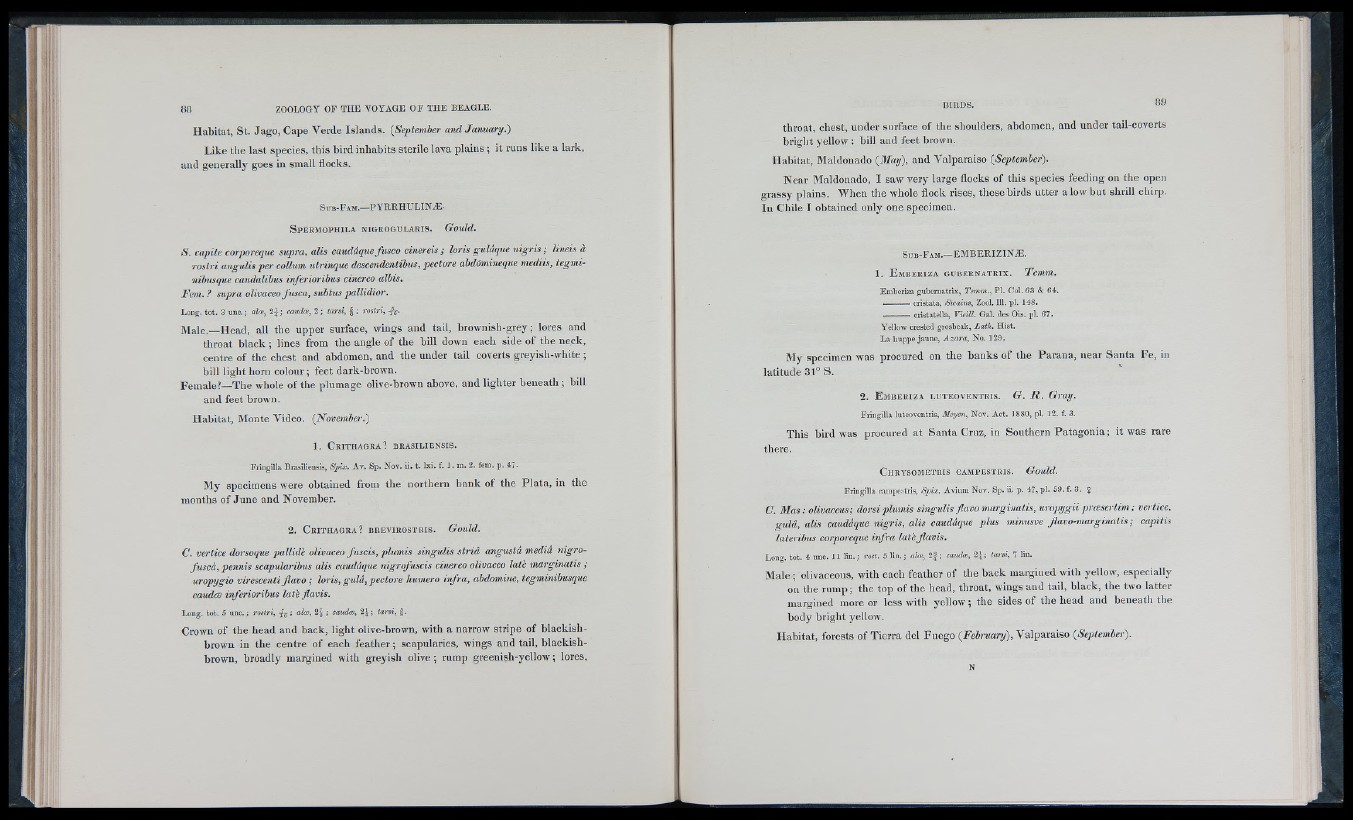
Habitat, St. Jago, Cape Verde Islands. (September and Januamj.)
Like the last species, this bird inhabits sterile lava plains ; it runs like a lark,
and generally goes in small flocks.
Sub-F am.— P Y R R H U L IN Æ .
S p e r m o p h i l a n i g r o g u l a r i s . Gould.
S. capite corporeque supra, alts catidacque fusco ciñereis ; loris guïaque nigris ; lineis a
rostri angulis per collum utrinque descendentibus, pectore abdómineque mediis, tegmi-
nibusque caudalibus inferioribus cinereo albis.
Fem. ? supra oliváceo fusca, subhis palUdior.
Long. tot. 3 unc.; aloe, cavdoe, 2 ; tarsi, | ; rostri,
fliale.—Head, all the upper surface, wings and tail, brownish-grey ; lores and
throat black ; lines from the angle of the bill down each side of the neck,
centre of the chest and abdomen, and the under tail coverts greyish-white ;
bill light horn colour ; feet dark-brown.
Female?—The whole of the plumage olive-brown above, and lighter beneath ; bill
and feet brown.
Habitat, Monte Video. (November.)
1 . C r i t h a g r a ? b r a s i l i e n s i s .
Fringilla Brasiliensis, Spix. Av. Sp. Nov. ii. t. Ixi. f. 1. ni. 2. fem. p. 4*.
My specimens were obtained from the northern bank of the Plata, in the
months of June and November.
2 . C r i t h a g r a ? b r e v i r o s t r i s . Gould.
C. vertice dorsoque pallidè oliváceo fuscis, plumis singulis stria angustá mediâ nigro-
fuscà, pennis scapularihus alis caudâque nigrofuscis cinei'eo oliváceo latè marginatis ;
uropygio virescenti flavo ; loris, gulâ, pectore humero infra, abdomine, tegminibusque
caudæ inferioribus latè Jiavis.
Long. tot. 5 unc.; rostri, alee, 2 | ; caudæ, tarsi,
Crown of the head and back, light olive-brown, with a narrow stripe of blackish-
brown in the centre of each feather; scapularies, wings and tail, blackish-
brown, broadly margined with greyish olive ; rump greenish-yellow ; lores,
throat, chest, under surface of the shoulders, abdomen, and under tail-coverts
bright yellow : bill and feet brown.
Habitat, Maldonado (May), and Valparaiso (September).
Near Maldonado, I saw very large flocks of this species feeding on the open
grassy plains. When the whole flock rises, these birds utter a low but shrill chirp.
In Chile I obtained only one specimen.
S u b - F am .— EMBERIZINA:.
1 . E m b e r i z a g u b e r n a t r i x . Temm.
Emberiza gubernatrix, Temm., PI. Col. 68 & 64.
----------cristata, Stcains, Zool. 111. pi. 148.
----------cristatella, Vieill. Gal. des Ois. pi. 67.
Yellow crested grosbeak, Lath. Hist.
La buppe jaime, Azara, No. 129.
My specimen was procured on the banks of the Parana, near Santa Fe, in
latitude 3 1 ° S.
2 . E m b e r i z a l u t e o v e n t r i s . G. R . Gray.
Fringilla luteoventris, Meyen, Nov. Act. 1880, pi. 12. f. 3.
This bird was procured at Santa Cruz, in Southern Patagonia ; it was rare
there.
C h r y s o m e t r i s c a m p e s t r i s . Gould.
Fringilla campcbtris, Spix. Avium Nov. Sp. ii. p. 47, pi. 59. f. 3. ?
C. 3Ias : olivacms; dorsi plumis singulis jiavo marginatis, uropygii proesertim ; vertice,
gulâ, alis caudâque nigris, alis caudâque plus mimisve Jlavo-marginaiis ; capitis
lateribus corporeque infra latè Jiavis.
Long. tot. 4 unc. 11 lin. ; rost. 5 lin. ; aloe, 2 | ; caudæ, 2^ ; tarsi, 7 lm.
Male ; olivaceous, with each feather of the back margined with yellow, especially
on the rump ; the top of tbe head, throat, wings and tail, black, the two latter
margined more or less with yellow ; the sides of the head and beneath the
body bright yellow.
Habitat, forests of Tierra del Fuego (February), Valparaiso (September).